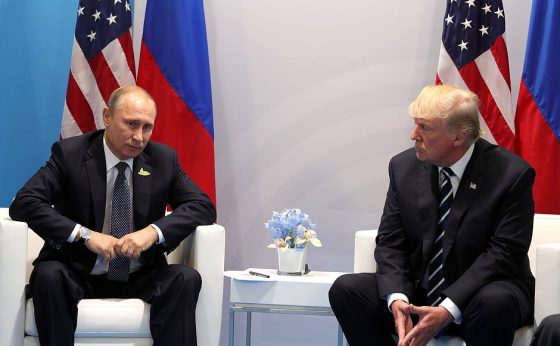BESA Center Perspectives Paper No. 698, December 26, 2017
EXECUTIVE SUMMARY: Tensions between Russia and the US have reached new heights over the past several weeks. Washington appears to be changing its military policy across the former Soviet space and is worried about Moscow’s close relations with Tehran and Ankara.
Relations between Moscow and Washington are at their lowest point since the end of the Cold War. This state of affairs was vividly reflected at the most recent meeting between Russian Foreign Minister Sergey Lavrov and US Secretary of State Rex Tillerson, at which the ministers discussed Syria, Ukraine, and North Korea but failed to achieve any significant breakthroughs on any front.
The differences between Moscow and Washington on the Middle East are becoming fundamental. Russia is not pleased with the American recognition of Jerusalem as Israel’s capital (despite its own recognition of West Jerusalem as Israel’s capital a few months earlier), and Washington is concerned that Russia has established high levels of cooperation with Turkey and Iran that could limit the projection of US power in the Middle East.
Because Russia’s long border with Turkey and Iran constitutes its gateway to the rest of the Middle East, the two countries have been a focus of post-Soviet Russian diplomacy. In the 1990s, they were pivotal to Moscow’s ambition to contain Western (primarily US) influence in the South Caucasus, Central Asia, and wider Middle East.
Russia, Turkey, and Iran each have their own interests in the Middle East, but they are all under pressure from the US. This could serve as a rallying point for them. In illustration of this trend, the Russian, Turkish, and Iranian presidents met in Sochi on November 22 to reaffirm their approach to the Syrian problem.
There are now more and more differences between Moscow and Washington over purely military affairs. On December 8, the US said it was considering military and economic measures against Moscow in response to its alleged violations of the Intermediate-Range Nuclear Forces Treaty (INF). The treaty, which was signed by the US and the Soviet Union, eliminated for the first time an entire class of cruise and ballistic missiles in Europe. The death of the INF would signal a further widening of the gap between the two superpowers.
Washington has compelled RT (Russia Today), the Russian television channel, to register as a “foreign agent,” while similar legislation has been passed by the Russian State Duma to target foreign (primarily US) media operating in Russia.
There have, to be sure, been positive moves in bilateral relations, including the recent transmission of secret information by US intelligence agencies to Russia that helped thwart terror attacks in St. Petersburg. This does not change the overall picture, however. Indeed, President Trump has unveiled a new US strategy document that assesses Russia as a major disturber of the international order.
Washington has also increased pressure on a theater in Moscow’s own backyard: Ukraine and Georgia. On November 13, US special envoy Kurt Volker met Kremlin aide Vladislav Surkov in Belgrade, Serbia, to discuss the possibility of stationing peacekeeping forces in eastern Ukraine. After the talks, the envoys indicated that their differences were so extensive that of 29 paragraphs, only three were acceptable to Russia.
Washington insisted that Moscow give up its control of the eastern Ukraine-Russia border, a demand the Russians dismissed out of hand. From a purely geopolitical standpoint, Russia’s acceptance of such terms would have meant sacrificing its ability to send military hardware into eastern Ukraine whenever it deems necessary.
On November 18, ABC News quoted a State Department source as saying that senior aides would present President Trump with a $47 million plan to finance and sell high-tech defensive weapons to Ukraine to bolster its efforts to repel Russian aggression in eastern Ukraine. One might, of course, take this with a grain of salt, as the US administration has been making such statements ever since Trump took office. This time, however, there are indications that Washington is considering changing its military policy across the former Soviet space.
In a related development, it has been announced that the US will be increasing its military support to Georgia. As of spring 2018, US Army officers will train Georgian soldiers on defensive tactics. Georgia has lacked defensive training for decades, as was clearly reflected in the 2008 Russo-Georgian war.
More importantly, on November 20, the US State Department approved the sale of Javelin anti-tank missiles to Georgia. Tbilisi plans to buy from the Pentagon 410 of the missiles and 72 launch units for a total $75 million.
The provision of this kind of weaponry will be a landmark development as it goes against the standard US approach to conflicts across the former Soviet Union: no supplies of lethal weapons to Ukraine, Georgia, or Moldova, so as to avoid escalation with Russia. The proposed sale might not materialize, but it nevertheless implies a change in the thinking of the American political establishment. Even if it goes through, it would not drastically change the military balance of power in the region – but it is nevertheless a significant enough development to cause concern in Moscow. After all, these military developments around Ukraine and Georgia resemble what NATO countries are doing in eastern Europe – namely, increasing their military capabilities with the help of the US.
Emil Avdaliani teaches history and international relations at Tbilisi State University and Ilia State University. He has worked for various international consulting companies and currently publishes articles focused on military and political developments across the former Soviet space.
BESA Center Perspectives Papers are published through the generosity of the Greg Rosshandler Family


